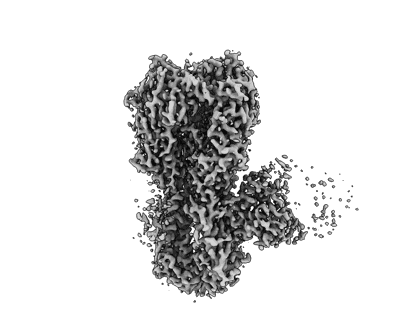EMD-42532
CryoEM structure of A/Perth/16/2009 H3 in complex with polyclonal Fab from mice immunized with H3 stem nanoparticles-28 days post immunization
EMD-42532
Single-particle2.7 Å
 Deposition: 30/10/2023
Deposition: 30/10/2023Map released: 08/05/2024
Last modified: 13/11/2024
Sample Organism:
Mus musculus,
Influenza A virus
Sample: A/Perth/16/2009 H3
Fitted models: 8ut7 (Avg. Q-score: 0.591)
Deposition Authors: Huang J, Han J, Ward AB
Sample: A/Perth/16/2009 H3
Fitted models: 8ut7 (Avg. Q-score: 0.591)
Deposition Authors: Huang J, Han J, Ward AB
Eliciting a single amino acid change by vaccination generates antibody protection against group 1 and group 2 influenza A viruses.
Ray R,
Nait Mohamed FA  ,
Maurer DP,
Huang J,
Alpay BA,
Ronsard L,
Xie Z,
Han J,
Fernandez-Quintero M,
Phan QA,
Ursin RL,
Vu M,
Kirsch KH,
Prum T,
Rosado VC,
Bracamonte-Moreno T,
Okonkwo V,
Bals J,
McCarthy C,
Nair U,
Kanekiyo M,
Ward AB,
Schmidt AG,
Batista FD,
Lingwood D
,
Maurer DP,
Huang J,
Alpay BA,
Ronsard L,
Xie Z,
Han J,
Fernandez-Quintero M,
Phan QA,
Ursin RL,
Vu M,
Kirsch KH,
Prum T,
Rosado VC,
Bracamonte-Moreno T,
Okonkwo V,
Bals J,
McCarthy C,
Nair U,
Kanekiyo M,
Ward AB,
Schmidt AG,
Batista FD,
Lingwood D
(2024) Immunity , 57 , 1141 - 1159.e11
 ,
Maurer DP,
Huang J,
Alpay BA,
Ronsard L,
Xie Z,
Han J,
Fernandez-Quintero M,
Phan QA,
Ursin RL,
Vu M,
Kirsch KH,
Prum T,
Rosado VC,
Bracamonte-Moreno T,
Okonkwo V,
Bals J,
McCarthy C,
Nair U,
Kanekiyo M,
Ward AB,
Schmidt AG,
Batista FD,
Lingwood D
,
Maurer DP,
Huang J,
Alpay BA,
Ronsard L,
Xie Z,
Han J,
Fernandez-Quintero M,
Phan QA,
Ursin RL,
Vu M,
Kirsch KH,
Prum T,
Rosado VC,
Bracamonte-Moreno T,
Okonkwo V,
Bals J,
McCarthy C,
Nair U,
Kanekiyo M,
Ward AB,
Schmidt AG,
Batista FD,
Lingwood D
(2024) Immunity , 57 , 1141 - 1159.e11
Abstract:
Broadly neutralizing antibodies (bnAbs) targeting the hemagglutinin (HA) stem of influenza A viruses (IAVs) tend to be effective against either group 1 or group 2 viral diversity. In rarer cases, intergroup protective bnAbs can be generated by human antibody paratopes that accommodate the conserved glycan differences between the group 1 and group 2 stems. We applied germline-engaging nanoparticle immunogens to elicit a class of cross-group bnAbs from physiological precursor frequency within a humanized mouse model. Cross-group protection depended on the presence of the human bnAb precursors within the B cell repertoire, and the vaccine-expanded antibodies enriched for an N55T substitution in the CDRH2 loop, a hallmark of the bnAb class. Structurally, this single mutation introduced a flexible fulcrum to accommodate glycosylation differences and could alone enable cross-group protection. Thus, broad IAV immunity can be expanded from the germline repertoire via minimal antigenic input and an exceptionally simple antibody development pathway.
Broadly neutralizing antibodies (bnAbs) targeting the hemagglutinin (HA) stem of influenza A viruses (IAVs) tend to be effective against either group 1 or group 2 viral diversity. In rarer cases, intergroup protective bnAbs can be generated by human antibody paratopes that accommodate the conserved glycan differences between the group 1 and group 2 stems. We applied germline-engaging nanoparticle immunogens to elicit a class of cross-group bnAbs from physiological precursor frequency within a humanized mouse model. Cross-group protection depended on the presence of the human bnAb precursors within the B cell repertoire, and the vaccine-expanded antibodies enriched for an N55T substitution in the CDRH2 loop, a hallmark of the bnAb class. Structurally, this single mutation introduced a flexible fulcrum to accommodate glycosylation differences and could alone enable cross-group protection. Thus, broad IAV immunity can be expanded from the germline repertoire via minimal antigenic input and an exceptionally simple antibody development pathway.
